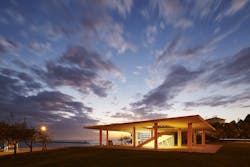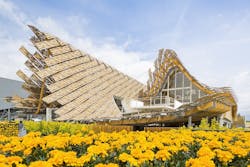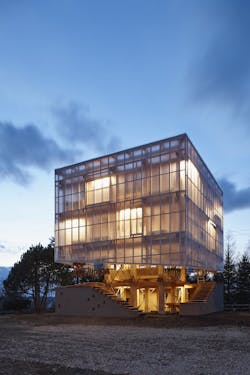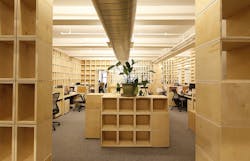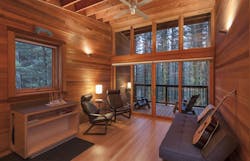BEST IN WOOD: WoodWorks announces 2016 design award winners
By David Malone, Associate Editor and WoodWorks
There is an old Chinese proverb that says, “A closed mind is like a closed book; just a block of wood.” It follows, then, that an open mind would be like an open book: intelligent, creative, and forward thinking.
So, what does this intelligence, creativity, and forward thinking do to that lowly old block of wood? Well, it transforms it into a beautiful work of art, much like those that have just been honored by the 2016 WoodWorks Wood Design Awards.
“The WoodWorks Wood Design Awards celebrate projects and design teams that showcase the innovative use of wood as both a structural and finish material,” said the Executive Director of the WoodWorks/Wood Products Council, Jennifer Cover, PE. These projects all exemplify the imaginative things that can be done to turn something as ordinary and recognizable as wood into beautiful and functional building designs.
There were nine categories of national awards: Multi-Story Wood Design, Commercial Wood Design, Wood in Government Buildings, Institutional Wood Design, Wood in Educational Buildings, Beauty of Wood – Innovation, Beauty of Wood – Craft, Green Building by Nature, and Green Building by Design. Additionally, there were seven Regional Excellence Awards that will be presented at regional Wood Solutions Fairs beginning in Minneapolis on March 23 with the North Central Wood Solutions Fair.
Below, we have compiled a list of our seven favorite projects that we have cherry-picked from this year’s winners. The seven structures are all very different in design and, for the most part, function, but share the common thread of being designed and built by individuals who looked at the ordinary and saw the extraordinary.
REGIONAL EXCELLENCE AWARD: WEST COAST CENTRAL
Aspen Art Museum, Aspen, Colo.
It makes sense that an art museum should, in and of itself, be a work of art. That is definitely the case with the Aspen Art Museum. Well known for his innovative use of wood, Pritzker Prize-winning architect, Shigeru Ban, envisioned a structural roof system for this project that required the creation of a unique, interlocking two-way wood frame to carry heavy Colorado snow loads as well as a basket-weave composite wood screen wall that envelopes the building. The floating plane of the 3-D space frame roof is supported on only a few clustered columns, cantilevering from interior to exterior where it supports the screen wall. The space frame is laid out on a 4-ft grid, with top and bottom laminated spruce veneer chords offset 2 ft in each plan direction. The diagonal webs that connect the top and bottom chords are comprised of gracefully curving, laminated birch plywood members that snake up and down, with dimensions that subtly shift in response to structural demands. The nodal connections for the space frame are made almost entirely with long, fully-threaded wood screws, installed from above to bind tight half-lapped joints, while remaining invisible to the building occupants. This 33,000-sf project was completed in 2014 for a construction cost of $45 million.
Building Team
ARCHITECT: Shigeru Ban Architects
STRUCTURAL ENGINEER: KL&A, Inc.
CONTRACTOR: Turner Construction
PHOTO CREDIT: Greg Kingsley, KL&A Inc.
WOOD IN GOVERNMENT BUILDINGS
Chicago Horizon, Chicago, Ill.
Known as the city that gave birth to the skyscraper, this award winning design is a tad different. Minimalistic and sleek, Chicago Horizon still represents plenty of firsts for the city of broad shoulders. Elegantly crafted, the pavilion represents the first use of exposed CLT in the City of Chicago, providing local precedent for the approval and use of mass timber for government and public assembly applications. In addition, the two-way slab roof is the first of its kind, and raises the possibility of new CLT applications (such as office and assembly) due to the open-plan layout it affords. A public pavilion for the Chicago Architecture Biennial, Chicago Horizon includes a cross-laminated timber (CLT) roof supported on 13 glulam columns distributed in a radial pattern to address lateral loads and uplift. The planned long-term use of the building as a commercial vendor and public assembly space is a significant and sustainable departure from the typical design exhibition model of temporary installations. The long-term plan justified the use of mass timber for durability, fire resistance, thermal mass, and negative carbon footprint. Chicago Horizon was completed in 2015 for a construction cost of $300,000.
Building Team
ARCHITECT: Ultramoderne
STRUCTURAL ENGINEER: Guy Nordenson & Associates
CONTRACTOR: FH Paschen
PHOTO CREDIT: Tom Harris, Hedrich Blessing
BEAUTY OF WOOD – INNOVATION
China Pavilion Milan Expo 2015, Milan, Italy
Like a giant wicker vegetable basket, the China Pavilion took a structure that could have been an eyesore and, instead, turned it into something that works in tandem with the environment. Designed as a temporary structure for Expo Milano 2015, the China Pavilion expands on the theme, Feeding the Planet – Energy for Life, with its focus on sustainability and the coexistence of nature and city. Although a variety of materials were considered, the team chose glulam to meet the challenges of the roof structure, including long spans and cantilevers, complex geometry, varying elevations and exposed framing. Transitioning from sharp angles to soft waves, the roof profile is accomplished with regularly spaced rafters, each with a custom curvature to match the evolving roof geometry. Longitudinal purlins with exterior bamboo sunscreens connect the structure’s sharp-edged rafters on the northern side to the soft waving rafters of the south. The architect’s vision of an open interior space was achieved by designing the long-span roof as a structural grid. To ensure the necessary stiffness, custom fixed-end connections were used between the purlins and primary timber rafters, while cable cross bracing within the grid offered additional strength. This 43,000-sf project was completed in 2015.
Building Team
ARCHITECT: Studio Link-Arc, LLC / Tsinghua University
STRUCTURAL ENGINEER: Simpson Gumpertz & Heger
CONTRACTOR: Bodino Engineering
PHOTO CREDIT: Sergio Grazia
GREEN BUILDING BY NATURE
Nest We Grow, Taiki-cho, Hiro-gun, Hokkaido, Japan
Each year, Japan’s LIXIL JS Foundation holds a university design competition focused on sustainable housing technologies. The 2014 theme was Productive Garden and the winning project, Nest We Grow, has since been constructed at the foundation’s Memu Meadows Farm. Described by the WoodWorks jury as an “intelligent structure,” Nest includes a skin of translucent polycarbonate over a glulam frame. The ground floor grid is comprised of nine composite columns, which are notched to receive the beams and girders, and connected with steel plates. Initial analysis called for both vertical and horizontal steel rod cross bracing due to strict building codes for seismic loads. However, the team was able to eliminate the horizontal steel cross bracing by using wood cross bracing in the two upper catwalks. In addition to the carbon stored in the wood, the team reduced the carbon footprint of Nest by using locally harvested and manufactured wood products. This 1,577-sf project was completed for a construction cost of $250,000 US.
Building Team
DESIGNER: University of California Berkeley College of Environmental Design
ARCHITECT: Kengo Kuma Architects & Associates
CONTRACTOR: Takahashi Construction Company
PHOTO CREDIT: Shinkenchiku-sha Co, Ltd.
REGIONAL EXCELLENCE AWARD: NEW ENGLAND
Office > Entropy, New York, N.Y.
Have you ever wondered what it would be like to work inside a beehive? You probably haven’t, but for anyone out there who has, it would probably be something like that which has been created with Office > Entropy. When discussing this project, the award jury used words like innovative, well detailed and cost effective. An office space for a non-profit organization in New York, Office > Entropy was a two-part undertaking. When the clients first approached the architect, they knew they’d soon need to move to a much larger space, which made adaptability a key objective. In response, the architect developed a system of office partitions and furniture comprised of basic plywood boxes of different sizes and rectilinear shapes. In the original space, the boxes that made up the partitions were arranged in a more random way, allowing for visual connectivity. In the larger space, the original boxes are re-organized literally and figuratively to create entire wall partitions of single box types, a simplification of texture that helps combat the complexity of a much more densely populated office. This 7,700-sf project was completed in 2015 for a construction cost of $450,000. In addition to resembling a beehive, does anyone else suddenly have a craving for waffles?
Building Team
ARCHITECT: Taylor and Miller Architecture and Design
CONTRACTOR: Taylor and Miller Architecture and Design
PHOTO CREDIT: Studio Dubuisson
REGIONAL EXCELLENCE AWARD: SOUTH ATLANTIC
Scott Family Amazeum, Bentonville, Ark.
Aesthetics and structural performance were the main reasons wood was chosen for this children’s discovery museum, which provides learning experiences through hands-on interactive exhibits. Visitors are greeted from the exterior with a striking, curved glulam roof, which resembles a gigantic smile, while the entrance pergola features both Southern Pine decking and exposed cedar beams. Cedar tongue and groove wood paneling both wraps the exterior and lines the interior, adding warmth, softness and color. The 50,000-sf structure embraces its setting, complementing its natural surroundings as well as another museum next door. This project was completed in 2015 for a construction cost of $12.2 million.
Building Team
ARCHITECT: Haizlip Studio, PLLC
STRUCTURAL ENGINEER: Crafton Tull
CONTRACTOR: Nabholz Construction
PHOTO CREDIT: Kenneth Petersen
BEAUTY OF WOOD – CRAFT
Whitetail Woods Regional Park Camper Cabins, Empire Township, Minn.
Kids love tree houses. Many a child has dreamed endlessly about what they would incorporate into their custom tree houses if they could. But because these tree house dreams often times never materialize, the dream lies dormant, buried deep inside each of us. Looking at the Whitetail Woods Regional Park Camper Cabins might just wake that dream from its slumber. Nestled into the hillside of a new regional park, three new camper cabins—built by county employees with the aid of high school students in a vocational training program—weave their way into a stand of pine trees. Built on concrete piers to minimize the impact on the surrounding wilderness, these beautifully detailed cabins hover between 14 and 16 ft above grade with trees almost at arms-reach, creating privacy and intimacy with the natural environment. Above the foundation, each structure is comprised of a red cedar glulam chassis, cedar and pine framing, and red cedar cladding. Dark cedar shingles on the exterior blend seamlessly with the beauty of the pine forest, while the interior is stained naturally to create an immersive warm environment. For this project, the beauty of wood was complemented by its sustainability, cost efficiency and ease of construction. The three 307-sf cabins were completed in 2014 for a combined construction cost of $225,000.
Building Team
ARCHITECT: HGA Architects and Engineers
STRUCTURAL ENGINEER: HGA Architects and Engineers
CONTRACTOR: Dakota County School District
PHOTO CREDIT: Paul Crosby
View all the winners of the 2016 WoodWorks Wood Design Awards here.


